EDITOR’S NOTE: A familiar name to Pioneer readers, Virginia Prowell has share her delightful poems with us for the last few years. Recently, Don Best shared a copy of Virginia’s book “Memory Tracks: The Diary of a Depot”. First published in 1994 with a 2nd edition in 2007, the book tells the story of the Rockaway Beach Train Depot from the building’s perspective. As Virginia herself explains, “If those walls could talk …” So she gave them a voice.
We will publish Virginia’s book as a series, with a chapter every few days, including the historical photos.
Enjoy this historical recollection of an iconic Rockaway Beach building.
VIRGINIA CARRELL PROWELL
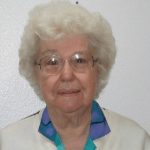
Virginia lived in the railroad building for 29 years. Her four children grew up in Rockaway and attended Rockaway Elementary and Neah-Kah-Nie High School. She worked at Rinehart Hospital and Clinic for 20 years. After breaking her leg in 1979, she retired from the Clinic, because she didn’t think her injury would allow her to do her work in the Physical Therapy department.
Staying home after all her children had left home was just too boring for her so with a neighbor, Jan Vanderpool, she opened Kitchen Ideas in Tillamook, Oregon This satisfied her restlessness, but with both her husband, Willard, and her commuting to Tillamook every day, they decided to move to Tillamook.
In 1986, her husband Willard retired; she sold the store so she could spend time traveling and fishing with him. Again she became restless, so decided to start writing her memoirs. At this time, she drove through Rockaway and saw the new owners remodeling the Old Depot. She thought to herself, “Oh my those walls should surely tell a lot of stories”. She promptly started researching it’s history and started writing about the depot.
Her husband passed away in 1988 and for a few years, the book was in limbo, but in 1991 when she married Clifford Prowell, he encouraged her to finish it. The first edition was published in 1994,
After new information came to light about the moving of the building, she decided to make a revised edition in 2007.
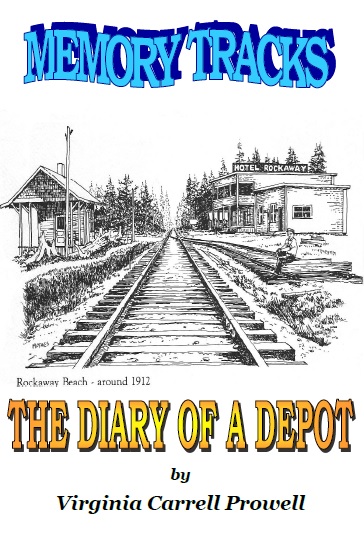
By Virginial Carrell Prowell
This book is fondly dedicated to my late husband, WILLARD W. CARRELL, who gave me so much encouragement to finish it.
Preface – The Depot and I sincerely hope you will enjoy the accounts of the memories of this historical building. It has been a pleasure for me to research all the happenings of the depot as well as be a part of its history while living within its walls.
Chapter I
Not just four walls and a roof, not just a flag or whistle stop, no, I was built to be a full fledged railroad station. My structure was a symbol of progress and hope for a newly developed portion of the country.
The Pacific Rail and Navigation Company, spear-headed by Elmer E. Lytle had completed a rail line from Hillsboro to Tillamook. In 1911, I started an existence that would see me through prosperity, fire, depression, two world wars, and several so-called conflicts.
Douglas Fir trees supplied the timber for my structure. The architectural design was a clone of most every railroad depot in the country. I was constructed with the sturdiest of lumber standards. The stringers were 8”x8” timbers, the floor joists, 2”x 10” (the measurements in those days were a full measurement, not planed to less than the full 2”x10”). The sub floor was 1”x8” shiplap and the flooring was 3/4”x4” tong and groove. The walls were a full 4” thick with 2”x4”s used as studs 16” on center. My ceiling joists were covered with 1 x 6 sheeting. The gentle swoop of my roof had a five foot overhang and was covered with cedar shakes.
South Third Avenue in Rockaway Beach, Oregon was my first location. The trains that stopped were hauling freight, and then in 1912, the big steam engine brought the first passenger train to town. It was a great event. All the people in town came to greet the tired passengers who had traveled from 9:00 a.m. to 2:30 p.m. train to town.
They had traveled 111 miles, went through 13 tunnels, the longest being 1,437 feet and had crossed 35 wooden bridges of at least 100 feet in length. The highest one was 167 feet. The train had taken them over mountains with the highest elevation of 1,835 feet. As the passengers disembark the train, their fatigue turned into awe and excitement at the sight of the blue Pacific Ocean pounding the sandy beaches and the friendliness of the townspeople greeting them. Many of these passengers were coming to look over the area in anticipation of purchasing some property. They had baggage a plenty including their tents. Several land agents were on hand ready to sell the property that had been subdivided into 25’ lots.
In the winter months, when no passenger trains were arriving, I was used as a Sunday school. I always looked forward to Sundays when the children would arrive. Their laughter and the singing liven up the otherwise dreary winter days. Mrs. Hart, the teacher, her son, Ed-ward, Lewis Best and his brother, Leo, and Dayle and Frank Miller were some of the individuals I remember. The boys stand out in my memory because they would always stoke the old potbelly stove on those cold and windy days.
As more and more people came to the beach, my baggage room was overflowing, so in 1913, they moved me North about a quarter of a mile. They enclosed the waiting area and built on an additional platform. Of course they had to add the little house out back for the comfort station. It was always painted the same color as my exterior and was one of the more popular stops of most of the passengers.
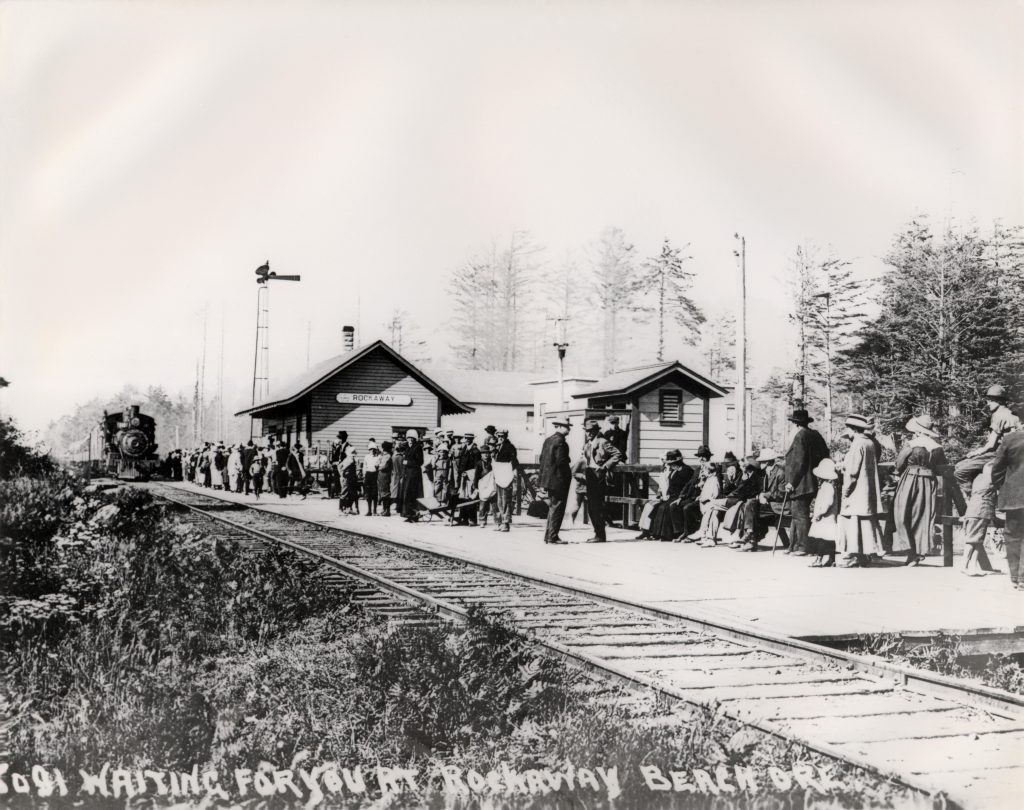
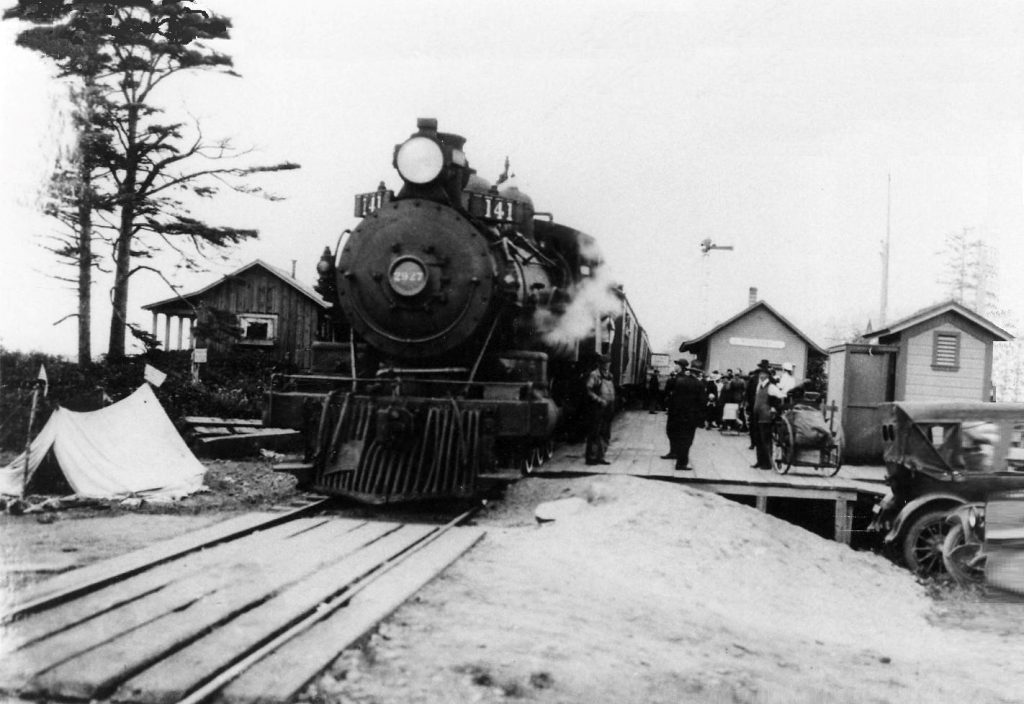
Rockaway Depot and Comfort Station
I must say, I stood quite majestic in this primitive setting. My dimensions were now 16’ wide by 68’ long and stood on the east side of the tracks next to Rockaway Creek (later called Rock Creek). The hillsides to the east were densely populated with old growth fir trees. Their windswept branches were evidence of the storms I would endure from the great Pacific Ocean to the west.
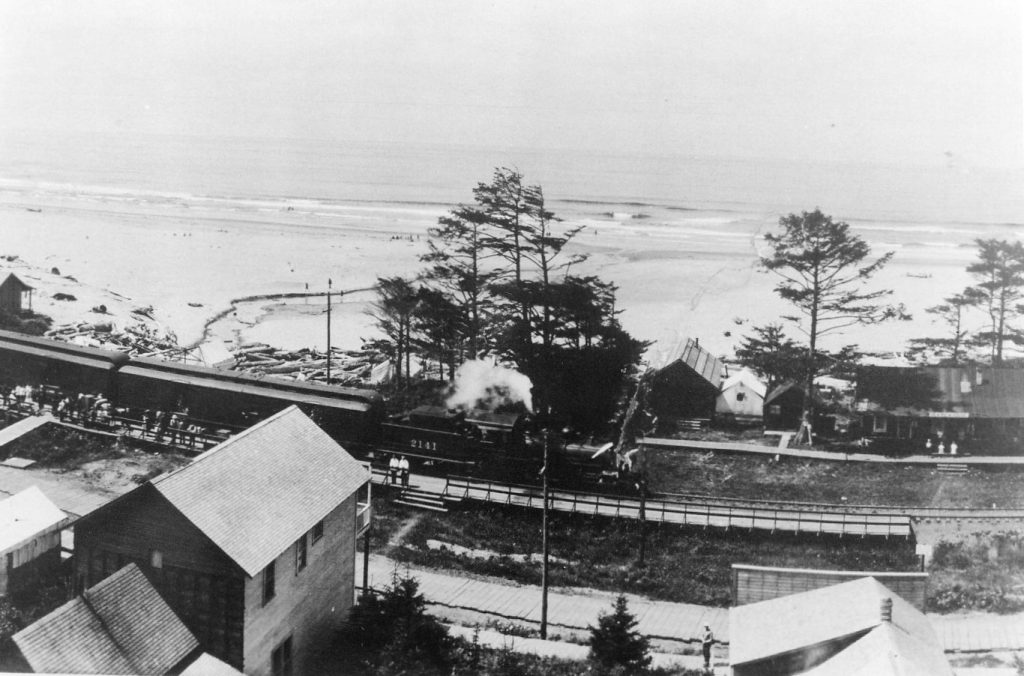
A panoramic view of the Pacific Ocean from the middle of town.
The town began to grow rapidly as more land agents advertised the area’s attributes. Advertisements expounded upon the pure mountain water, broad, clean, hard sand beaches. Financing was made easy with low down payments, no interest and no taxes. What a bargain! No wonder the people flocked to this promise land.
As each new structure was started, a feeling of pride spread through my timbers. This would mean more people would be arriving on the trains and the more people that came, the more vital I felt. Two grocery stores were already here … the Miller family was one of the first to build but soon there was the Byers Grocery, the Russell Grocery and of course, the big Elmore Hotel on the South end. Ida Miller was the Postmistress and I saw her on a regular basis when she picked up the mail from the train. She was most thankful for the railroad because the mail was arriving earlier now than it had when it came by boat or horse.
Tents with wooden floors lined the beach area waiting to be occupied by the summer vacationers. The arrival of the trains always shook the ground and the houses built on the sand. This shaking was my cue to come alive and greet the wide-eyed passengers. Each Saturday, during the summer months, the train would arrive loaded with families looking forward to the excitement of a beach vacation. Watching the ladies depart from the train was like viewing the latest fashion parade. Their long dresses were covered with street length coats, capped at the shoulders with different adornments. Every properly dressed lady was also adorned with a chapeau to match her coat. Most of the men wore suits, always a tie and a hat atop his head. Little girls wore long coats and bonnet type hats, boys wore knickers pants, jackets and caps.
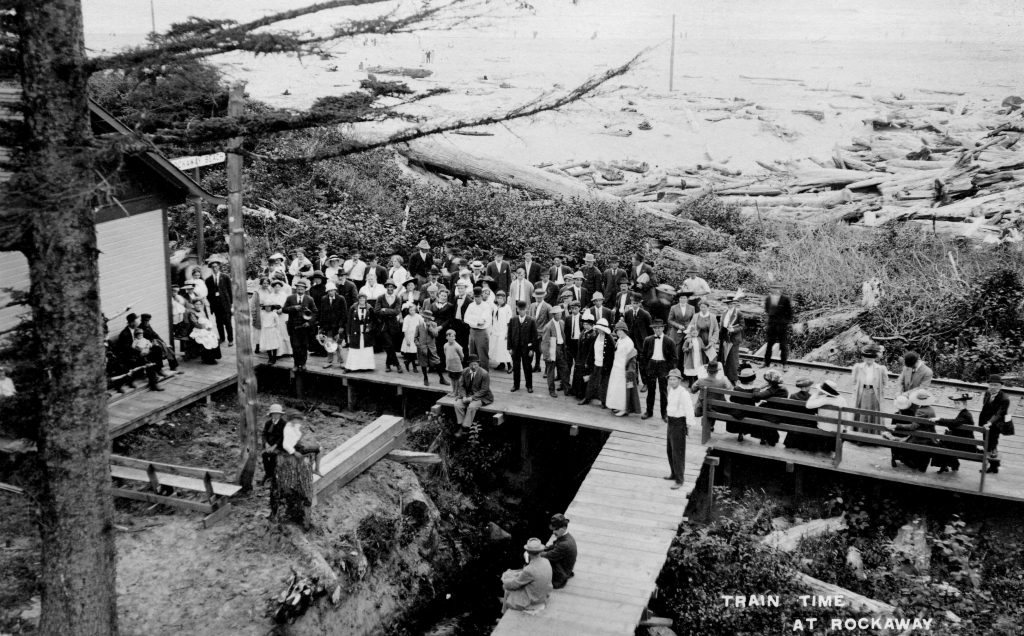
Vacationers waiting for the train in Rockaway.
It was fun to watch the young newcomers. They could hardly wait to get their baggage off the train so they could go into the water. For many it was a rude awakening when they plunged into that cold salt water. A rope securely attached on the beach provided a “life line” for many swimmers as they entered the wild waves.
The following Friday afternoon, the “Daddy Train” would arrive. The entire town including the vacationing families would crowd around my platform to greet the fathers and husbands who came down for the weekend. Many people stayed the entire summer in those days. I got to know many of the young people who would come daily to see what was going on at the depot. Two young fellows, Dayle Miller and Frank Coles sold newspapers. Dayle’s father had the Oregonian Agency so the boys were “Johnny on the spot” to sell the newspapers when the trains pulled in. The Peanut Butcher, who sold candy, peanuts, and newspapers on the train, was out of luck when these boys were on hand because they always had the news first.
Besides the regular train, the “Dinky” ran between Mohler and Tillamook twice a day during the summer. When the tides were low a great many people would ride the dinky train down the beach and dig a limit of clams and then ride back on the afternoon train. They would get off the dinky with their buckets loaded with clams and crabs. From the looks of their muddy and sandy clothes, it must have been a lot of work, but you would never have guessed it by the smiles on their faces and the good-natured fun and laughter.
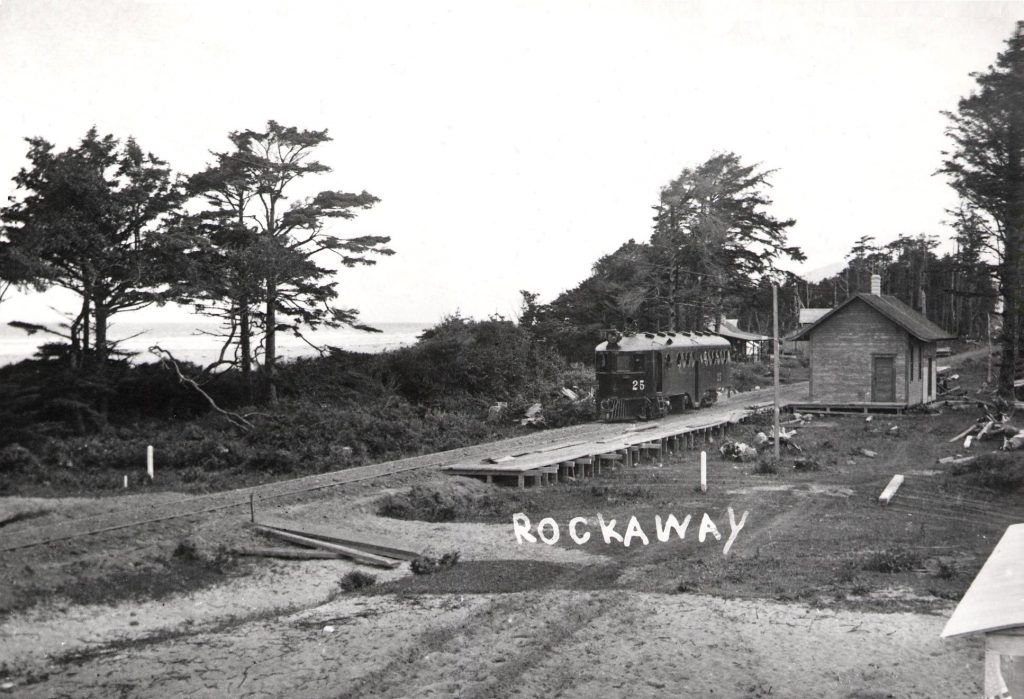
The dinky train with the original depot.
World War I was raging overseas in France and Germany. The papers were filled with stories of soldiers dying by the thousands, not only from the war, but many from influenza. Even in this country, influenza took its toll. The war didn’t seem to have too much of an effect on the tourist trade in this remote area. People were still spending their vacations at the beach, perhaps they came down here to forget the troubles that were facing the nation.
Spruce lumber was in big demand to be used for air-planes. The loggers, dubbed “Wooden Soldiers”, were regulars at the dance hall down the street. Not only the loggers, but visitors from all over the area would flock to the Rockaway Dance Hall. Weekend trains were filed with passengers looking forward to the good times. Many people thought of those times as ‘days of moonlight and roses,’ romantic times in their lives when lovers met and danced the nights away.
The dance hall brought a host of great bands throughout the years. Members of the bands would come down to my docks and be the main greeters of passengers on Friday and Saturday nights. Their music set my 2 x 4’s tapping. It was like a great holiday every weekend when the trains pulled in.
Most of the time, passengers and visitors to the depot were fin good spirits but the day the telegram arrived from Reverend Jones who stayed in Manhattan, the mood was regretfully sad. His daughter was to arrive soon on the train from New Jersey where she lived with her husband and children. The telegram revealed the distressing news that her husband had been killed in an arsenal fire.
I didn’t see much of this family except when they arrived each year and when they left for the winter. Mrs. Jones was ill and came to the coast each year for her health. In 1920, a couple of fellows from the station helped the family load her on the train because she be-came too ill to stay any longer. Her youngest daughter, Carrie, a shy little girl, sat on the big benches, dwarfed by my high ceilings and tall windows. The smell of cigar smoke mixed with the odors of freshly oiled floors filled her nostrils and remained in her memories. Her older brothers were always near her side to protect her. After the mother died, the rest of the family continued to return every summer.
They bought old Matt Maroney’s cabin and rebuilt it for daughter, Margaret’s home. One of the boys, Arthur, met his bride at Manhattan Beach. Both of the Jones boys became doctors in the years to come. Carrie married a druggist later and didn’t move back until the 1940’s.
Art Kirkham was one of our baggage men and ticket sellers. Was he ever a jolly fellow, always whistling and singing as he attended to his duties. He had a great laugh too, and all the people enjoyed talking to him. He not only worked at the depot, he also sang at the dance hall and played the piano at the movie theater to accompany the silent movies.
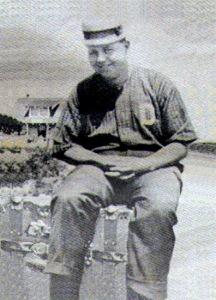
Art KirkHam
Picture taken from Rosemary Walker’s “Memories of Rockaway Oregon by the Sea”
In later years he moved to Portland and became a well known TV personality for KOIN.
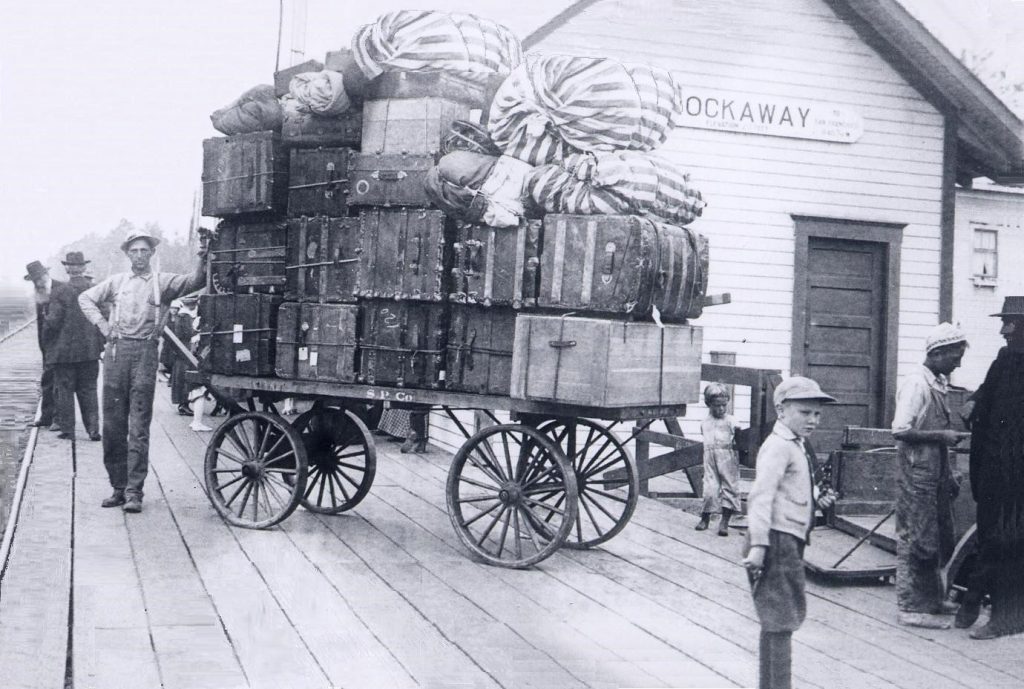
Photos taken in 1919, suggests a lot of people traveled by rail to this famous resort town.
Al Schloth was a familiar figure around the depot. He was an enterprising fellow, seemed to dabble in a variety of ventures. With his baggage cart, he’d meet all the trains that pulled in and helped the passengers and the baggage men get the luggage and tents off the train. Al would pile trunks and tents on that old wagon twice as high as his head and then deliver it around town to the passengers. Along with the baggage cart, he also ran a Merry-go-round that young and old enjoyed. He and a fellow named, Jasman, were partners in a grocery and variety store. Jasman was a particular fellow about his grocery supplies coming in on the train. The bread came in big boxes, unwrapped. He would pay some of the young fellows around town to keep the kids from sitting on the bread boxes.
(TO BE CONTINUED … Memory Tracks: The Diary of Depot – Chapter 2 – The 1920’s)
Acknowledgements:
I would like to acknowledge the following people for their part in my research: The late Rosemary Walker, who gave me permission to use parts of her accounting of Rockaway in her publication, MEMORIES OF ROCKAWAY, OREGON BY THE SEA. Also to Doris Painton Wingrove, Marie Schram, Carrie Cornis, Don Sutherland, the late Marion Drollinger, to Don Best, for many of the pictures. To my four children who told me of some of their behavior and happenings of which I was previously unaware; and to my many friends who have given me so much encouragement.
The cover picture is compliments of Lee Mothes, Ocean Studios.
Special thanks to my daughters, Susy and Claudia, who helped with editing my manuscript and to my son-in-law, Mike Moore, who helped me with formatting and publishing this book. Also a special thanks to my husband, Clifford Prowell, for his dedicated support.
In this second edition, I want to acknowledge, Waldo Caufield, one of the college students who helped move the building. He related to me the procedure they used.
Also in this second edition, I would like to thank, Don Best, Ruby Fry-Matson from the Pioneer Museum in Tillamook who helped me get more pictures. Last by not least, to Marc Crump, who worked many hours with me in editing and publishing the revised edition of “Memory Tracks.”

